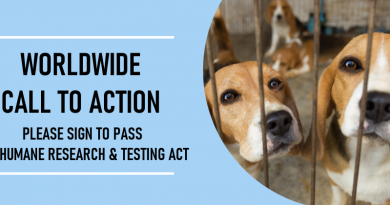Modernizing the Canadian Environmental Protection Act (CEPA)
What’s the Issue?
The Canadian Government has introduced Bill S-5 into the Senate to modernize the Canadian Environmental Protection Act (CEPA). One proposed amendment is the inclusion of a statement in the preamble of the act that endeavours “to reduce, refine or replace the use of animal testing [clause 2(5)]”
While this is a great start, it doesn’t go nearly far enough for protecting animals. We need the government to move the preamble statement into the Act itself so that the reduction and replacement of animals for toxicity testing becomes legally mandated. Add your voice to this effort!
Take Action to End Toxicity Testing On Animals
We decided to put together this blog post to explain why toxicity testing on animals is conducted, non-animal methods that can be used instead, and how the push to reform CEPA can help ensure unnecessary and harmful animal tests are no longer a part of toxicity testing in Canada.
Toxicity Testing on Animals
Toxicity testing has traditionally been carried out on a wide variety of animal species including rodents (mice, rats, guinea pigs)and fish, and to a lesser degree, rabbits, dogs and nonhuman primates. This tradition has its roots in the tools that were available decades ago, and is based on the assumption that any adverse effects seen at high doses in animals will also be seen if high doses of the same substance were given to humans.
Toxicity testing is carried out to study the potentially harmful effects of chemicals on human health, animal health, or the environment, all with the aim of ensuring the safest possible use of chemicals and chemical-containing products. Toxicity testing is typically carried out on detergents, pesticides, medicines for human or veterinary use, toys, medical devices, tobacco-containing products etc., chemicals that are intentionally added to or inadvertently found in food and feed, and chemicals found in the environment.
In the context of human health safety assessment, the main types of animal-based toxicity tests are conducted for: acute toxicity (skin and eye irritation/corrosion, acute systemic toxicity), allergenicity (skin and respiratory sensitization), repeat-dose toxicity, genotoxicity and mutagenicity, carcinogenicity, reproductive and developmental toxicity, and biokinetics (also referred to as toxicokinetics or pharmacokinetics). The protection goal in these cases is the individual (ie. The human)
The main types of animal-based toxicity tests conducted for environmental safety assessment are acute and chronic toxicity (including growth, survival and reproductive success) in fish, acute and chronic toxicity in crustaceans, acute toxicity testing on birds, and bioaccumulation (typically in fish). The protection goal in these cases is the population, community, or ecosystem.
Replacing Animals in Toxicity Testing
Non-animal methods are becoming increasingly available, making it possible to assess the safety of chemicals without animal testing in many circumstances. The science of non-animal methods continues to evolve rapidly, and demonstrates that such methods can be more rapid and cost-effective, and provide more accurate information about chemical risks compared with traditional animal testing.
Because developing and implementing non-animal methods for toxicity testing results in better science to better protect environmental and human health – and in order to protect tens of thousands of animals from use in unnecessary painful or lethal toxicity testing – jurisdictions such as the EU and US have incorporated strong legal tools in their toxics laws to reduce and replace the use of animals in toxicity testing. Canada is now set to catch up.
The Push to Modernize CEPA – What’s Happening with Bill S-5?
Canada is in the midst of modernizing the Canadian Environmental Protection Act, 1999 (“CEPA”) – our national toxics law. This presents an exciting opportunity to better protect the environment and health of Canadians while phasing out the unnecessary use of animals in painful toxicity testing and positioning Canada as a global leader when it comes to developing non-animal testing methods.
During the 2021 federal election, the Liberal Party of Canada committed to ending the use of animals in toxicity testing by 2035. This commitment follows a similar commitment made by the US Environmental Protection Agency, while the Netherlands has committed to phasing out most types of animal testing, including toxicity testing, by 2025. However, without overarching legislation for animal-based science in Canada, there are very few ways to legally mandate the replacement of animals in science. Amending CEPA is one of those opportunities.
CEPA is currently silent on requiring the use of non-animal methods. Bill S-5 would amend the Act’s preamble to recognize the need to reduce and replace the use of animals in toxicity testing, but it does not contain any legally binding requirements to ensure animals are used only as a last resort, or that the commitment to end the use of animals entirely by 2035 is met.
We’re working to make sure that the proposed statement in the preamble about reducing and replacing animals in toxicity testing is moved to become a provision within the act itself. But we need your help!
Will you join us and send a letter asking the government to end toxicity testing on animals?
Ask Canada to End Toxicity Testing On Animals




